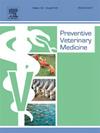Animal rabies in the Nizhny Novgorod region of Russia (2012–2024): Descriptive and predictive epidemiological analysis
IF 2.2
2区 农林科学
Q1 VETERINARY SCIENCES
引用次数: 0
Abstract
The aim of this study was to reveal spatiotemporal patterns of emergence of rabies cases in various animals in the Nizhny Novgorod Oblast (a region in the center of the European part of the Russian Federation) from 2012 to 2024, and to identify areas with the highest exposure to the disease using regression models and time series analysis. During the study period, a total of 676 cases of rabies were registered, with 60.10 % among wild species, 31.52 % among domestic (companion) animals, and 7.51 % among livestock animals. The transmission of rabies in the study area is especially driven by wild animals, particularly the red fox (Vulpes vulpes). Livestock forms a separate population that hardly can present a link of the rabies virus transmission but rather may be sought as an indicator of the virus presence in animals. A regression model with a good predictive power (R2=0.63) revealed the number of settlements, population density, population size of foxes and road length as the main explanatory factors for the number of cases of rabies by administrative units. ARIMA, which stands for Autoregressive Integrated Moving Average Model, was used for short-term time-series-based forecasting of animal rabies cases in the districts of the Nizhny Novgorod region. According to the ARIMA forecast, the number of rabies cases among all animals is expected to be 6–23, and particularly up to 15 cases in foxes for the season throughout 2025. This study provides important epidemiological information for veterinary services, including an expected number of animal rabies cases by population. This information may be of some interest in the planning of vaccination strategies.
俄罗斯下诺夫哥罗德地区动物狂犬病(2012-2024):描述性和预测性流行病学分析
本研究的目的是揭示2012年至2024年下诺夫哥罗德州(俄罗斯联邦欧洲部分中部地区)各种动物狂犬病病例出现的时空格局,并利用回归模型和时间序列分析确定疾病暴露最高的地区。研究期间共报告狂犬病病例676例,其中野生动物60.10 %,家养(伴侣)动物31.52 %,家畜7.51 %。狂犬病在研究地区的传播主要是由野生动物,特别是红狐(Vulpes Vulpes)推动的。牲畜是一个单独的种群,几乎不能说明狂犬病病毒传播的联系,但可以作为动物中病毒存在的一个指标。回归模型预测能力较好(R2=0.63),居民点数量、人口密度、狐狸种群规模和道路长度是影响区域狂犬病发病数的主要因素。ARIMA(自回归综合移动平均模型)用于下诺夫哥罗德地区各区基于时间序列的动物狂犬病病例短期预测。根据ARIMA的预测,所有动物中狂犬病病例的数量预计将达到6-23例,特别是在整个2025年的季节中,狐狸的狂犬病病例将高达15例。本研究为兽医服务提供了重要的流行病学信息,包括按人口计算的动物狂犬病病例数。这一信息可能对疫苗接种战略的规划有一定意义。
本文章由计算机程序翻译,如有差异,请以英文原文为准。
求助全文
约1分钟内获得全文
求助全文
来源期刊

Preventive veterinary medicine
农林科学-兽医学
CiteScore
5.60
自引率
7.70%
发文量
184
审稿时长
3 months
期刊介绍:
Preventive Veterinary Medicine is one of the leading international resources for scientific reports on animal health programs and preventive veterinary medicine. The journal follows the guidelines for standardizing and strengthening the reporting of biomedical research which are available from the CONSORT, MOOSE, PRISMA, REFLECT, STARD, and STROBE statements. The journal focuses on:
Epidemiology of health events relevant to domestic and wild animals;
Economic impacts of epidemic and endemic animal and zoonotic diseases;
Latest methods and approaches in veterinary epidemiology;
Disease and infection control or eradication measures;
The "One Health" concept and the relationships between veterinary medicine, human health, animal-production systems, and the environment;
Development of new techniques in surveillance systems and diagnosis;
Evaluation and control of diseases in animal populations.
 求助内容:
求助内容: 应助结果提醒方式:
应助结果提醒方式:


